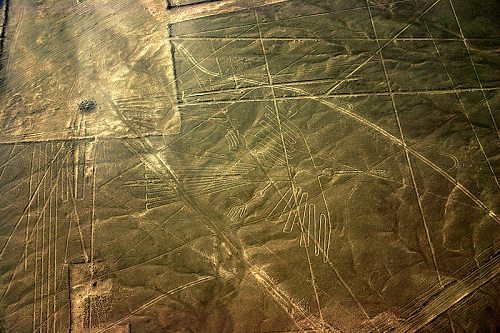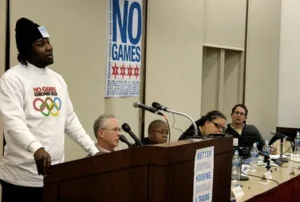
An unbelievably counterproductive action conceived and conducted by Greenpeace activists has made political bedfellows of Fox News and Vladimir Putin.
Putin’s Russia Today (RT) news source has barely been able to contain its chortling in reporting about Greenpeace’s executive director, Kumi Naidoo, appearing before a Peruvian court to apologize for the intrusion of people associated with Greenpeace into a UNESCO World Heritage Site containing the fragile Nazca Lines, etchings made 1,500 to 2,000 years ago, to lay out cloth letters, visible by airplane, that read, “Time for change! The future is renewable! Greenpeace.” Unfortunately, the Nazca Lines are not renewable and may have been damaged irreparably. Putin has had a cold spot in his heart for Greenpeace for a long time, certainly since the Greenpeace icebreaker, Arctic Sunrise, deposited some Greenpeace activists on a Gazprom oil rig in the Pechora Sea, which resulted in Russia’s seizing the boat and arresting 30 onboard.
No friend of Putin’s regime, Fox News has also been intrepidly following the Greenpeace debacle in Peru, in contrast to the limited coverage the story has received from other sources. Fox has written about the Greenpeace “publicity stunt” and Greenpeace’s rather ham-handed efforts to explain and apologize, including Greenpeace’s initial response that its activists were “absolutely careful” not to disturb the Nazca geoglyphs, when it is well known that access to the area is restricted due to the inevitability of damage from people’s footprints, and its subsequent statement that the Greenpeace understands “that this looks bad.” Fox has been no less a critic of Greenpeace over the years, notably giving extensive airtime on Hannity and other shows to former Greenpeace member Patrick Moore (billing himself inaccurately as a co-founder of Greenpeace) who has become a public dissenter against the notion of manmade climate change.
Sign up for our free newsletters
Subscribe to NPQ's newsletters to have our top stories delivered directly to your inbox.
By signing up, you agree to our privacy policy and terms of use, and to receive messages from NPQ and our partners.
Despite the new convergence of Fox and Putin, there is no question that Greenpeace stumbled badly in its protest at the United Nations Climate Change conference in Peru earlier this month. Despite Naidoo’s public apology and the removal of the Greenpeace lettering, the damage has been done. Aerial flights still show the outlines of the letter “c” from “Greenpeace” along with footprints in the fragile sand and rock, and Peruvian authorities say that there are no known techniques for fixing the damage Greenpeace caused. Naidoo’s offer that Greenpeace and Peru work together to protect the site may sound almost cynical, given that the damage was caused by Greenpeace itself and cannot be remedied.
What should be done now? What would you do if you were Naidoo, trying to handle a devastating crisis for the organization?
- Would you cooperate with the authorities and turn over the perpetrators? Naidoo has said that the action by the activists, whom various reports have counted as between seven and 20, was not organized by or even known by him and top Greenpeace brass. Given that the action was well planned and organized, however, including having recruited an aerial flyover for photographs, this denial is a little hard to believe. Still, it’s what Greenpeace has said. Naidoo has also said, however, that Greenpeace would cooperate with Peruvian authorities in the investigation of the incident, which could result in prison time for those found guilty of desecrating an archeological site. However, Naidoo so far apparently hasn’t been willing to turn over the names of the activists. In a meeting with Peruvian authorities, Greenpeace executives actually said that they didn’t know the names of the activists involved, which Luis Jaime Castillo, Peru’s vice minister for cultural heritage, described as a “joke.” According to Minister of Culture Diana Alvarez, the Greenpeace activists were from other South American countries and from Europe and might be subject to extradition. Even though the Greenpeace perpetrators have departed, some are well known to have participated, either by their own public statements or having been caught on videotape, including the leader of the effort, Mauro Fernandez, who heads Greenpeace’s Andean Climate and Energy Campaign (in an interview after the incident, Fernandez reportedly tried to justify the action and denied that any damage had been caused). If you were Naidoo and Greenpeace, given the extraordinary damage your associates might have caused to a unique and fragile site, would you turn over the names of the activists for prosecution? Or would you decline to do so, perhaps because they were working to raise the issue of renewable energy for the awareness of the politicians meeting in Lima?
- How would you make reparations? Regardless of the prosecution of the people involved, Greenpeace has damaged a site with more than 70 zoomorphic designs, including the hummingbird where Greenpeace activists mounted their display, and other designs of plant life and flowers. The site was already suffering problems from environmental changes, deforestation, and squatters. Greenpeace has offered to pay for the restoration of the Nazca Lines site, at least the part where Greenpeace mounted the action, but if there are no known techniques for restoring the site, what would Greenpeace pay for—and how much could it possibly pay? Given the lack of restorative technology, is there anything that Greenpeace can affirmatively do in response to the damage its people have caused?
- How would you deal with the implications for developing nations?One of the serious implications of this action is that largely foreign environmentalists flew to Peru to conduct this action and flew out, without much or any consideration of Peruvians themselves. It feeds a narrative that environmentalists are at the minimum tone deaf to the developing world, impervious to what peoples and countries in the global South really want and value. By causing damage to a Peruvian archeological site, Greenpeace has added to the perception that developed world environmentalists are insensitive to the developing world’s needs, values, and priorities. Greenpeace has damaged its own “brand,” so to speak, but damaged that of other environmentalists as well. Is there a corrective action that Greenpeace can take, not only on its own behalf, but to help the image and reputation of the other environmentalists who might be aghast about what Greenpeace activists did in Peru?
- How would you proceed with future public relations–oriented advocacy actions? Had Greenpeace not happened upon a UNESCO World Heritage Site where it caused clear damage, the idea of having its climate change message spelled out in large letters to be seen from the air (for delegates from the 190 nations attending the conference to see as they flew into Peru) might have gotten a lot of attention. Its damage to the Nazca Lines has gotten Greenpeace attention, but not the kind it wanted. Has the trend toward symbolic, attention-getting advocacy actions aimed at making a splash and getting headlines and social media circulation turned counterproductive in itself? Are too many groups trying to find more and more outrageous or outlandish advocacy actions—ice bucket challenges, Kony “paint the town red” campaigns, and now Greenpeace lettering on an archeological site—where the point is being lost as the effort to get attention is overtaking the meaning? Greenpeace was not trying to marry Putin and Fox News in an anti-Greenpeace campaign, but it has managed to achieve that unlikely pairing. Would you alter Greenpeace’s attention-getting advocacy approaches, especially now that donors and supporters are expressing reservations about Greenpeace in the wake of the Nazca Lines incident?
Greenpeace is a long-admired organization whose activists have risked not only imprisonment, as in Russia with the Arctic Sunrise, but physical harm, with the French navy’s sinking of the Rainbow Warrior in New Zealand before it joined a protest against French nuclear weapons tests in the Pacific. It has been admirably persistent and courageous in its activism on climate change, nuclear power, genetically modified foods, and much more. The Nazca Lines incident threatens to reverse much of Greenpeace’s trajectory of accomplishments and perhaps inalterably damage its organizational credibility and trust. What would you do if you ran Greenpeace?—Rick Cohen
Disclosure: Rick Cohen once served on an advisory board with Greenpeace CEO Kumi Naidoo when Naidoo was head of Civicus












